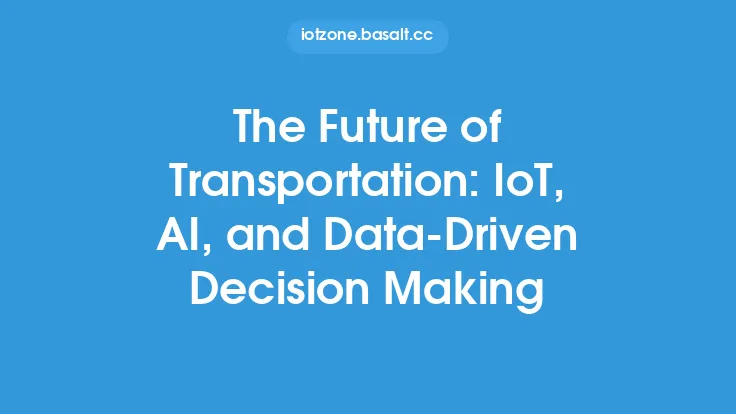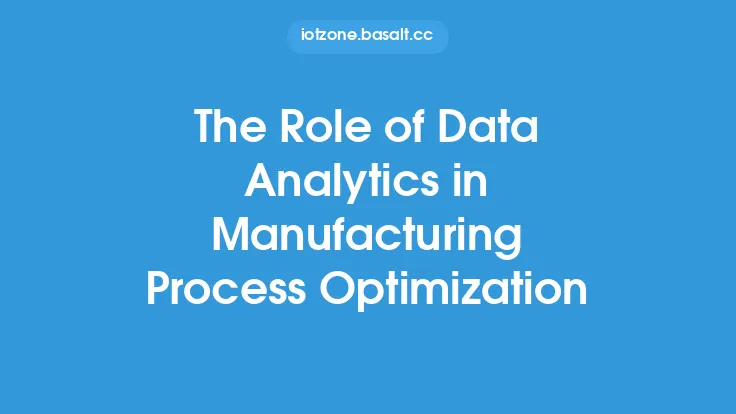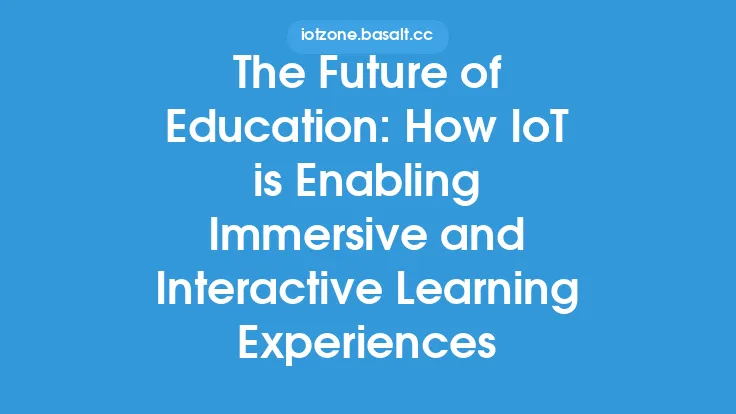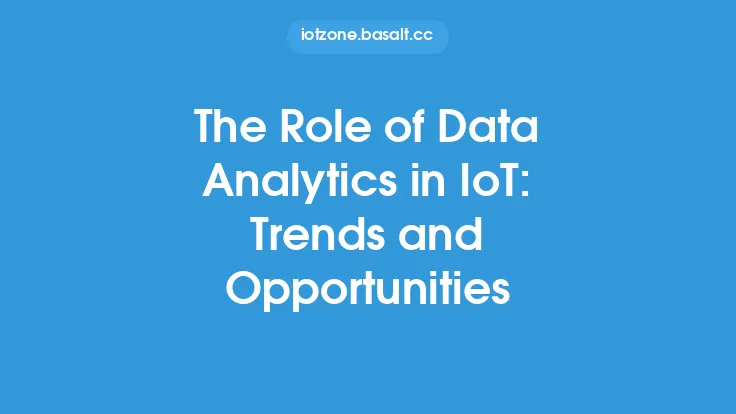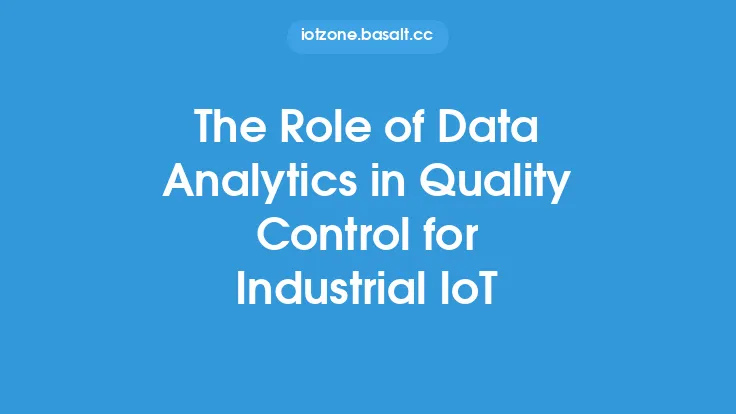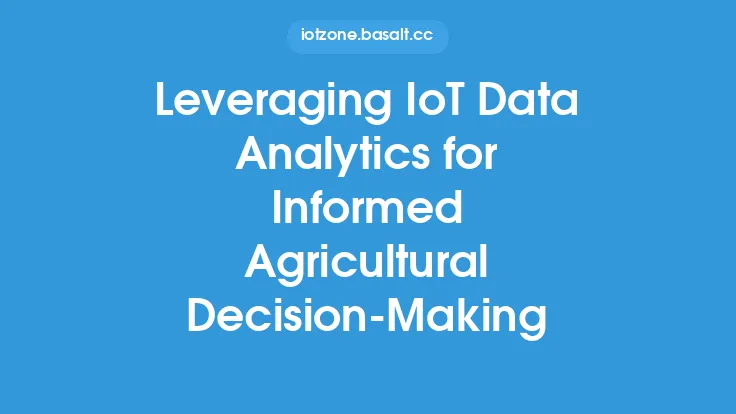The Internet of Things (IoT) has revolutionized the way we live and work, with an ever-increasing number of devices connected to the internet, generating vast amounts of data. As the IoT continues to grow, the importance of data analytics in driving decision-making cannot be overstated. Data analytics is the process of examining data sets to conclude about the information they contain, and in the context of IoT, it involves analyzing the vast amounts of data generated by connected devices to gain insights and make informed decisions.
Introduction to IoT Data Analytics
IoT data analytics is a sub-category of data analytics that deals specifically with the analysis of data generated by IoT devices. It involves using various techniques such as machine learning, statistical analysis, and data visualization to extract insights from IoT data. The goal of IoT data analytics is to provide actionable insights that can be used to improve business operations, enhance customer experience, and drive innovation. With the exponential growth of IoT devices, the amount of data generated is increasing exponentially, making it essential to have a robust data analytics framework in place to extract valuable insights.
Types of IoT Data Analytics
There are several types of IoT data analytics, including descriptive analytics, diagnostic analytics, predictive analytics, and prescriptive analytics. Descriptive analytics involves analyzing historical data to understand what happened, while diagnostic analytics involves analyzing data to understand why something happened. Predictive analytics involves using statistical models and machine learning algorithms to forecast what may happen in the future, and prescriptive analytics involves using data analytics to provide recommendations on what actions to take. Each type of analytics has its own strengths and weaknesses, and the choice of which one to use depends on the specific use case and business requirements.
IoT Data Analytics Architecture
The architecture of an IoT data analytics system typically consists of several components, including data ingestion, data processing, data storage, and data visualization. Data ingestion involves collecting data from various IoT devices, while data processing involves cleaning, transforming, and analyzing the data. Data storage involves storing the processed data in a database or data warehouse, and data visualization involves presenting the insights gained from the data in a user-friendly format. The architecture of an IoT data analytics system can be complex, and it requires careful planning and design to ensure that it can handle the large volumes of data generated by IoT devices.
IoT Data Analytics Tools and Technologies
There are several tools and technologies available for IoT data analytics, including open-source platforms such as Apache Kafka, Apache Spark, and Apache Hadoop. These platforms provide a scalable and flexible framework for processing and analyzing large volumes of IoT data. Additionally, there are several commercial platforms available, such as IBM Watson IoT, Microsoft Azure IoT, and Google Cloud IoT Core, which provide a comprehensive set of tools and services for IoT data analytics. The choice of which tool or technology to use depends on the specific use case and business requirements, as well as the level of expertise and resources available.
Challenges and Limitations of IoT Data Analytics
Despite the many benefits of IoT data analytics, there are several challenges and limitations that need to be addressed. One of the major challenges is the sheer volume and variety of IoT data, which can be difficult to process and analyze. Additionally, IoT data is often noisy and incomplete, which can make it difficult to extract accurate insights. Furthermore, IoT data analytics requires specialized skills and expertise, which can be difficult to find and retain. Finally, there are several security and privacy concerns associated with IoT data analytics, which need to be addressed to ensure that sensitive data is protected.
Real-World Applications of IoT Data Analytics
IoT data analytics has a wide range of real-world applications, including industrial automation, transportation, healthcare, and smart cities. In industrial automation, IoT data analytics can be used to optimize production processes, predict maintenance needs, and improve product quality. In transportation, IoT data analytics can be used to optimize traffic flow, predict traffic congestion, and improve safety. In healthcare, IoT data analytics can be used to monitor patient health, predict disease outbreaks, and improve treatment outcomes. In smart cities, IoT data analytics can be used to optimize energy consumption, predict crime patterns, and improve public services.
Future of IoT Data Analytics
The future of IoT data analytics is exciting and rapidly evolving. With the increasing use of artificial intelligence, machine learning, and deep learning, IoT data analytics is becoming more sophisticated and accurate. Additionally, the use of edge computing and fog computing is enabling real-time processing and analysis of IoT data, which is improving the speed and accuracy of decision-making. Furthermore, the increasing use of cloud computing and big data analytics is enabling the processing and analysis of large volumes of IoT data, which is driving innovation and business growth. As the IoT continues to grow and evolve, the importance of data analytics in driving decision-making will only continue to increase.
Best Practices for Implementing IoT Data Analytics
To get the most out of IoT data analytics, it is essential to follow best practices for implementation. This includes defining clear business objectives and use cases, selecting the right tools and technologies, and ensuring that data quality and security are maintained. Additionally, it is essential to have a skilled and experienced team in place to design, implement, and maintain the IoT data analytics system. Finally, it is essential to continuously monitor and evaluate the performance of the IoT data analytics system, and make adjustments as needed to ensure that it is meeting business objectives and driving decision-making.
Conclusion
In conclusion, IoT data analytics is a critical component of the IoT ecosystem, enabling businesses and organizations to extract valuable insights from the vast amounts of data generated by connected devices. With the increasing use of IoT devices, the importance of data analytics in driving decision-making will only continue to grow. By understanding the types of IoT data analytics, the architecture of an IoT data analytics system, and the tools and technologies available, businesses and organizations can unlock the full potential of IoT data analytics and drive innovation and business growth. Additionally, by following best practices for implementation and addressing the challenges and limitations of IoT data analytics, businesses and organizations can ensure that they are getting the most out of their IoT data analytics investments.
